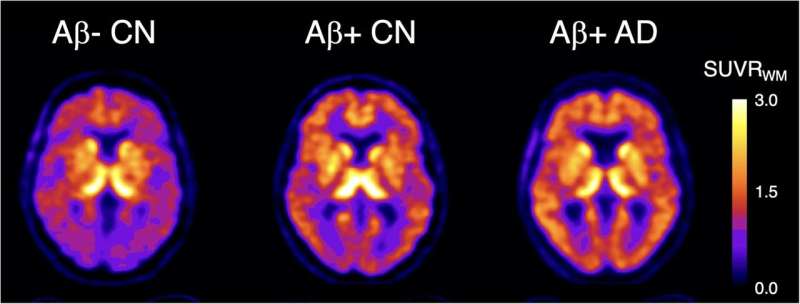
A new highly selective PET imaging agent can detect the presence of overexpressed monoamine oxidase-B (MAO-B) in cognitively unimpaired individuals with high beta amyloid (Ab)—one of the earliest signs of Alzheimer’s disease—according to research published in the October issue of the Journal of Nuclear Medicine.
The radiotracer, 18F-SMBT-1, allows for a better understanding of the role of inflammation in Alzheimer’s disease, which can enable more accurate staging and prognosis at earlier stages. Brain inflammation that accompanies Alzheimer’s disease involves reactive astrocytes, which are cells that overexpress MAO-B.
The newly developed 18F-SMBT-1 radiotracer is highly selective for MAO-B and as a result has increased binding to reactive astrocytes. “This increased binding suggests that 18F-SMBT-1 can potentially be used as a surrogate marker to detect reactive astrogliosis in Alzheimer’s disease,” noted Victor Villemagne, MD, professor of psychiatry at the University of Pittsburgh in Pittsburgh, Pennsylvania.
The study aimed to characterize 18F-SMBT-1 binding to reactive astrocytes across the Alzheimer’s disease continuum. Study participants included three clinical groups: 57 cognitively unimpaired controls, 12 subjects meeting criteria for mild cognitive impairment (MCI), and eight subjects meeting criteria for Alzheimer’s disease.
Participants underwent several types of imaging, including 18F-SMBT-1 PET, Ab PET, tau PET, and MRI. Images were normalized and statistical analyses conducted to assess 18F-SMBT-1 binding in relation to Ab and tau pathology burden. 18F-SMBT-1 was found to be highly correlated with Ab burden, and much less with tau burden.
The three clinical groups were then classified based on their Ab status (either as Ab+ or Ab-). No significant differences in 18F-SMBT-1 binding were found among Ab- participants in the control and MCI groups. In the Ab+ subjects with Alzheimer’s disease, 18F-SMBT-1 binding was significantly higher. Most importantly, 18F-SMBT-1 binding was significantly higher in the Ab+ control group as compared to Ab- control group.
“It’s of note that the brain regions where we saw this higher 18F-SMBT-1 binding in the control group are regions known for early Ab deposition. This suggests that reactive astrocytes are associated with early Ab deposition at the preclinical stages of Alzheimer’s disease and likely play a role over clinical progression,” said Villemagne.
Source: Read Full Article
